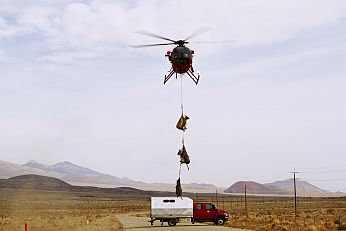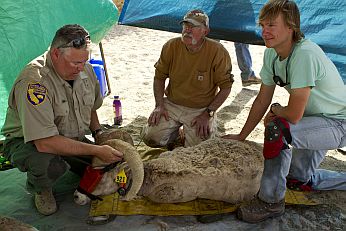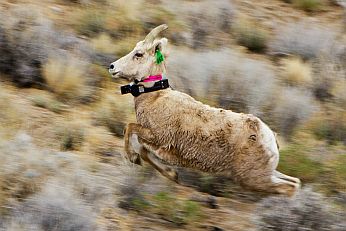Reintroductions
On March 26, 2015, this herd unit was established in the heart of Yosemite National Park. Initially, 8 pregnant ewes and 1 non-pregnant ewe were released. Three days later, 3 rams were released, and on April 3 a final pregnant ewe was released, bringing the total population up to 13 animals. Each bighorn was fitted with a satellite GPS collar allowing daily monitoring of their movements and health for the first 2 years. Two of the rams died during the first year and only two lambs survived, but the rest of the population fared well. During the second year the ewes were not bred and no lambs were observed. Subsequently, in 2016 and 2017 a total of 7 rams were released into this population. After two severe winters, the Cathedral herd continued to persist and reproduce. In 2018 four lambs were observed, and in 2020 one lamb was observed. However, by 2020 only a single ewe from the original translocations remained alive, and her collars were no longer functioning. When conditions are favorable we plan to augment and collar this herd to aid in its recovery. After the heavy winter of 2022-23, only rams are believed to survive here.
Olancha Peak - complete
March 25, 2013 marked the first translocation to create a new Sierra Nevada bighorn sheep herd since 1986 when the Mono Basin herds at Mt. Warren and Mt. Gibbs were first repopulated. Ten pregnant ewes and four rams were released in Olancha March 25-26. Each was fitted with a satellite GPS collar allowing daily monitoring of their movements and health for the first 30 months. During the first year of observation all animals seemed to adapt well to their new home. Lambing season, May-July, resulted in 8 documented lambs. In May 2013, one ram returned home about 25 miles north to the Mt. Langley herd unit, leaving three rams remaining. In 2014, 2015, and 2018 Olancha was augmented with a total of 4 ewes and 3 rams to increase genetic diversity and reproductive potential.
Even though 7 animals from the original translocation stock had died, in September 2016 over 30 bighorn were counted. Such an increase in 3 years bodes well for this population, and indeed, the population has continued to increase. In 2019, our total count was up to 45 animals. In the heavy winter of 2022-23, when many Sierra herds were decimated, the only herd to increase was Olancha (total of 58), the farthest southern herd in the Sierra.
Big Arroyo is located in the Great Western Divide and is part of the Kern River recovery unit. On March 2014, this herd unit became occupied for the first time since the early twentieth century. Ten pregnant ewes and 3 rams were initially released. Each was fitted with a GPS collar allowing daily monitoring of their movements and health for the first 40 months after release. In 2018, 3 more ewes and 2 rams were released in Big Arroyo. Similar to the strategy at Olancha Peak, additional bighorn releases are planned for this population to augment the original herd.
Since this area is geographically isolated from the main body of the Sierra Nevada, this herd serves as an important reservoir of bighorn separate from the east side populations. Creating a herd in the Great Western Divide area has some additional logistical challenges compared to most other herd units. Monitoring of these populations requires significant effort, with more than 25 miles of backcountry travel to get there. In the first several years after the original reintroduction, population increases in this herd were modest, but the population increased gradually as time went on. In 2017 and 2020 we were able to capture and collar a total of 7 animals in the herd, 5 of which were new animals that had been born within the herd unit, increasing our ability to monitor the remote population. In 2020, we counted a total of 28 animals in Big Arroyo.
This herd was decimated in the heavy winter of 2022-23. We've had reports and remote camera sightings of a few individuals since then but no ewes that we know of.
Laurel Creek, similar to Big Arroyo, is located in the Great Western Divide and is part of the Kern River recovery unit. On March 30, 2015, this herd unit was populated for the first time since the early twentieth century. Seven pregnant ewes and 4 rams were released. Each was fitted with a GPS collar allowing daily monitoring for the first 40 months after release. Another 4 rams were released on November 1, 2016. Similar to the strategy at Big Arroyo and Olancha Peak, additional bighorn releases are planned for this population to augment the original herd.
Since this area, like Big Arroyo, is geographically isolated from the main body of the Sierra Nevada, the herd serves as an important reservoir of bighorn. Monitoring these populations requires significant effort, with more than 25 miles of backcountry travel to get there. The Laurel Creek population has persisted and reproduced since the original reintroductions, but hasn’t grown in number. In 2020 we counted a total of 6 animals. This herd was decimated in the heavy winter of 2022-23.
Taboose Creek - colonization in progress
This herd unit, adjacent to Sawmill Canyon and just south of Coyote Flat, appears to be in the early stages of natural colonization. In 2012 our field crews started observing rams within the herd unit boundaries, and in the following years we observed a small number of ewes as well. We began capturing and collaring ewes there in 2015 to monitor the new population, and in 2017 we saw our first lambs born in herd unit boundaries. In 2020, we observed a total of 4 ewes and 2 lambs. Depending on how the colonization progresses, we may decide to assist the process through augmentations, or we may let it proceed naturally and monitor the new population over time.
Augmentations
This herd was originally augmented when 6 pregnant ewes were moved to Lundy Canyon from Wheeler Ridge and Mt. Langley in 2009. All 6 of the ewes survived at least two years and produced lambs. During the next three years, 3 perished. Two rams were moved to Mt. Warren in 2003. The following year one ram was hit by a car on Conway Summit and perished. The other survived for nine more years and likely sired offspring and increased heterozygosity in the population. After the heavy snowfall winter of 2017-18, this herd’s numbers were greatly diminished, and we were down to a single collared ewe. In 2020, we augmented the herd with 6 more ewes from Wheeler Ridge. Five of these animals were pregnant when moved and successfully gave birth to lambs in the spring, further increasing the population at Warren. We will continue to monitor the population to determine if future augmentations will be necessary to ensure population viability.
This herd was augmented with 3 ewes, 2 of which were pregnant, from the Mt. Langley herd in 2013 because genetic analysis had indicated low genetic diversity. The newly-arrived ewes were selected for high genetic diversity to help increase the genetic diversity of the herd in an attempt to raise the low reproductive rates observed in past. On April 3, 2015, we added an additional 5 pregnant ewes with the intention of creating a new deme or subpopulation just south of the current population in the Algers Creek area. These ewes, with known genetics, were specifically selected to increase the genetic diversity of this herd.
In 2024 the Gibbs ewe population had dropped to 2 after many snow-related deaths. In an attempt to save the herd, we translocated 5 pregnant ewes from the Mt. Baxter herd in March, 2025.
Convict Creek
This herd was augmented with 3 pregnant ewes from Mt. Langley in 2013. This very small population should benefit by increasing the number of ewes to complement and assist the natural colonization. The translocated ewes were selected for high genetic diversity to help ensure that the genetic stock remains diverse. Having collared animals in this newly colonized area helps to define habitat usage patterns and assist in comprehensive population surveys.
Five pregnant ewes were moved to Mt. Baxter from the Wheeler herd in 2005. Later that year 3 of the translocated ewes moved north to Sawmill Canyon. One of the remaining ewes moved south to Mt. Williamson in 2007. All 5 ewes survived to reproduce for at least two years. Four of the relocated ewes were killed by mountain lions between 2007 and 2009. The remaining ewe survived and reproduced at Mt. Baxter for many years. This herd is currently large enough to be a source for translocation stock rather than requiring additional augmentation.
Mt. Langley was augmented with a single ram from the Wheeler Ridge herd in 2001. He was released farther north, in the Mt. Williamson area, but moved south over a period of several months and became a permanent resident of the Mt. Langley herd for at least 6 years. This herd was large enough to be a source for translocation stock for many years, but recently has seen tremendous declines, due in part to increased mountain lion predation. In 2016 the number of ewes was estimated at 49, and by the summer of 2020 this estimate was down to 17. Langley is no longer large enough to be a source population and will be considered for future augmentations.
"Many endangered species remain on the brink of extinction with poor prospects for recovery after they receive federal protection. Through our conservation efforts, we have a unique opportunity to reach recovery goals for an alpine specialist that is native only to California."
—Program Manager Tom Stephenson
Video
Yosemite Nature Notes #27.
Video describing March 2014 reintroduction effort.
Video describing March 2013 reintroduction effort.
Photos
 Helicopter ferrying in Sierra bighorn. Photo courtesy Lucas Barth.
Helicopter ferrying in Sierra bighorn. Photo courtesy Lucas Barth.
 Sierra bighorn at processing site during translocation. Photo courtesy Lucas Barth.
Sierra bighorn at processing site during translocation. Photo courtesy Lucas Barth.
 Released ewe heads off towards Olancha Peak. Photo courtesy Lucas Barth.
Released ewe heads off towards Olancha Peak. Photo courtesy Lucas Barth.